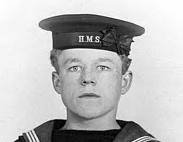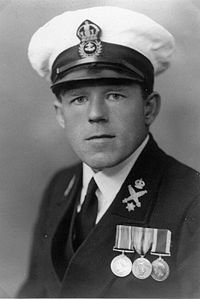- Author
- A.N. Other
- Subjects
- Biographies and personal histories, History - WW1, History - WW2
- Tags
-
- RAN Ships
- None noted.
- Publication
- June 2011 edition of the Naval Historical Review (all rights reserved)
Claude Choules was the last known combat veteran living in Australia who had served in both world wars. When he died recently, in Western Australia, our last tangible link with World War I was severed. Thus a man who had served in the Royal Navy Grand Fleet in 1917-18 as an unknown and obscure Boy Seaman became the last of the many millions of men and women who saw active service in what became known as the Great War.
Claude was born on 3 March 1901, in the town of Pershore, Worcestershire but grew up in the small village of Wyre Piddle a few miles away. In April 1915 he fibbed about his age and at age 14, he joined the nautical training ship Mercury, moored at Southampton, and it was in this three masted sailing ship that he learned the mariner skills he was to require for a career at sea. When he turned 16 he was accepted into the Royal Navy with initial training in HMS Impregnable, at one time a 140 gun square rigged wooden ship of the line. He later joined his first sea-going ship, the battleship HMS Revenge. He served in her throughout 1917 – 18 on operations in the North Sea, and was present at the surrender of the German High Seas Fleet on 21 November 1918. He was also present at Scapa Flow in the Orkney Islands on June 21 1919 when German Admiral Ludwig von Reuter ordered his interned fleet to be scuttled. Of note is that while Claude served in the Royal Navy during World War I his two older brothers, who had emigrated to Australia, served in the 1st AIF.

After the Armistice, Claude continued to serve in the Royal Navy and by 1923 had been promoted to Leading Torpedoman. In early 1926 he accepted an offer to serve on exchange with the Royal Australian Navy as an instructor at Flinders Naval Depot. This would mean early promotion to Petty Officer and a chance to visit his older brother and sister. While traveling to Australia on the passenger ship SS Diogenes he met Ethel Wildgoose, a Scot who was going to Melbourne to become a nanny, and within a year they were married. He also made the bold decision to transfer to the RAN and later became a member of the commissioning crew of the cruiser HMAS Canberra, in which he served until 1931.
In early 1931, at age 30, Claude left the Navy in order to provide more family stability as he had a wife and two young children. He helped his brother run a fruit and vegetable business and also spent a year as a prison officer at Fremantle Gaol, but in late 1932 he rejoined the Navy as a Chief Petty Officer Instructor at the Naval Training Depot in Fremantle.
When World War II broke out in 1939 he was still serving in Western Australia and became the Torpedo Officer for the port of Fremantle. His duties over the next six years of war included disposal of the first German mine to wash up on Australia’s shores, demolition work and maintaining mine sweeping equipment. In 1942, when there was a distinct possibility of a Japanese invasion, he was responsible for preparing demolition charges for the destruction of the port of Fremantle and its supporting infrastructure, and placed depth charges in ships unable leave Fremantle Harbour. After the war Claude stayed on in RAN as an instructor and explosives specialist.

In 1950, he turned 50 years of age and would normally have retired from the Navy but instead was offered, and took, the opportunity to transfer to the Naval Dockyard Police, whose retiring age was 55. After finally retiring from the RAN in 1955 after 41 years service in naval uniform he went on to live for another 55 years, in which he enjoyed crayfishing, sailing and spending time with his wife, children and grandchildren. In 2007 his wife of 80 years died and in 2009 his autobiography The Last of the Last was published. Claude passed away in the Gracewood Hostel in Perth on 5 May 2011, survived by his three children, 13 grandchildren, 26 great-grandchildren and two great-great-grandchildren.




